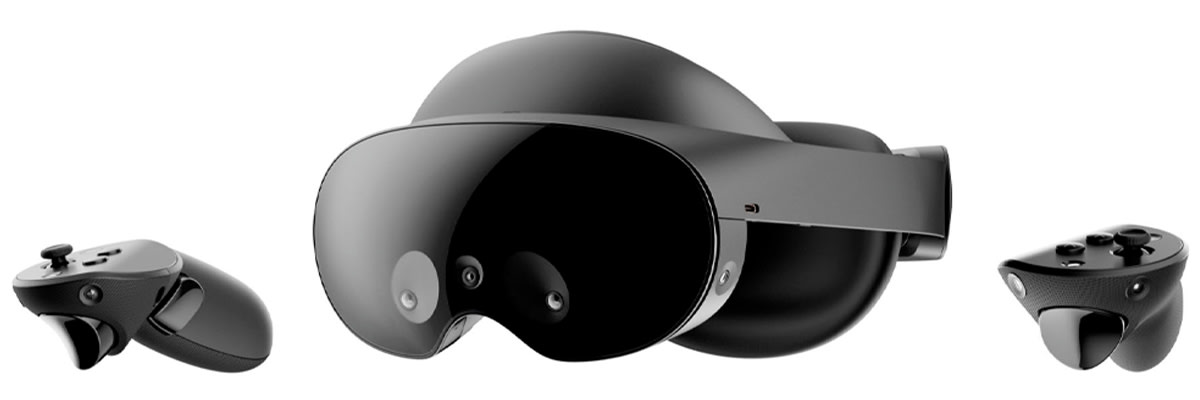The Meta Quest (also known as the Oculus Quest) is one of the most well-known VR headsets on the market. However, there are dozens of other popular options available such as the Valve Index, HTC Vive, and Sony PlayStation VR. Another popular competitor (outside of the US) is the new PICO 4.

Return navigate_next
Pico 4 Versus Oculus (Meta) Quest Pro VR Headsets
November 4, 2022 *
What Is the PICO 4 VR Headset?
PICO is a VR brand that is owned by ByteDance. The company has created several VR headsets, including the PICO G2 4K/4K Plus, PICO Neo3 Pro/Pro Eye, PICO Neo3 link, and, most recently, the PICO 4.

The headset has a balanced design that evenly distributes the weight of the headset, so users don’t feel weighted down even after wearing the headset for multiple hours. It also has a ski goggle design with pancake lenses to make it as comfortable and snug as possible.
Compared to PICO’s older headset models, the PICO 4 reduces the front weight by 26.2% and the thickness by 38.8%. The headset’s 5300mAh battery is at the back of the device to fully balance the weight.
PICO 4 VR Headset Specs
PICO focused most of its attention on creating a lighter and more comfortable VR headset. As such, the front width of the product is 163 mm, with a height of 80mm and a length that ranges from 255mm to 310mm (depending on how you choose to fit the strap).
The PICO 4 has a Qualcomm XR2 processor with 8 Cores and 2.84GHz. PICO sells two models with either 128GB of storage for €429 or 256GB of storage for €499. In addition, the headset supports wireless connections with WiFi 6.
Some of the important features to consider include the following:
- Resolution: 2,160 ✕ 2,160 per eye
- Refresh rate: 72Hz / 90Hz
- Pancake Lens
- 105° Field of vision
- 6DoF Positioning System
- Integrated high-fidelity speaker
- 5300mAh with 20W fast-charging battery
When you order the PICO 4, you’ll receive everything you need in the box. This includes two controllers, a glasses spacer and nose pad, controller lanyards, a USB-C power adapter, and a USB-C to C 2.0 data cable. Overall, the PICO 4 promises impressive specs, especially for a fairly new competitor in the VR world. However, the PICO 4 doesn’t have plans to release in the US yet.

Meta Quest Pro Specs
The Oculus Rift VR was the first modern VR headset released to the market. Since then, the company has improved its design. The most recent release is the Meta Quest Pro.
The Meta Quest Pro costs $1,499.99 and is one of the most impressive VR headsets on the market. First, it allows users to customize their immersive experience. Users can choose to open up their peripheral vision to allow for partial immersion, so they can be in the headset and still aware of their surroundings.
The headset also allows for full-color mixed reality and has a resolution that is 4x higher than the Quest 2. If you’re using an avatar, the headset will also track and mimic your facial expressions, even minute expressions like winks and eyebrows movement.
Like the PICO 4, the Meta Quest Pro also uses a pancake lens and optic technology. As a result, it has 37% more pixels per inch compared to the Quest 2. It also comes with 256GB of storage, 12GB of RAM, and has a Snapdragon XR2+ processor for 50% better performance than the Quest 2.
The Meta Quest Pro is a great headset for gamers; however, it targets business professionals more. Its partial immersion is perfect for meetings, and the Meta Quest Touch Pro Controllers allow users to manipulate VR objects with precision.
How Does the PICO 4 Compare to the Meta Quest VR Pro Headset?
The PICO 4 and the Meta Quest VR Pro target different audiences. While the Pico 4 is a great option for gamers, the Meta Quest VR Pro is the better headset for professionals. However, gamers can also consider purchasing the Meta Quest 2 for $399.99.
The Meta Quest 2 is a better comparison for the PICO 4 because it shares the same audience. It’s a gaming headset that includes fast refresh rates, high resolution, and 3D positional audio. The Meta Quest 2 is available with 128GB or 256GB of storage.
It’s no surprise that the Meta Quest 2 is the most popular VR headset. However, the PICO 4 seems to be a good competitor for markets outside of the US.

Do You Need an Extended Warranty for Your VR Headset?
Having a VR headset can make gaming feel more immersive. You can also use VR headsets for visual working projects, meeting up with friends remotely, or exercising. However, VR headsets are often exposed to accidental damage, which makes it essential to pair the device with an extended warranty from Upsie.
Upsie’s warranties cover accidental damage, including drops, liquid spills, and screen damage. In addition, Upsie will protect your device from the following:
- Manufacturing defects
- Dead pixels
- Power failure
- Speaker and sound issues
- Flash memory failure
Upsie offers two-year and three-year extended warranties for VR headsets released in the US. Until the PICO 4 releases in the US, Upsie cannot warranty the product. Luckily, Upsie does warranty the Meta Quest 2 and other US-released products. You can purchase an Upsie warranty for VR headsets that have a retail price of up to $999.99.
* This article is over 6 months old and may or may not be updated.
